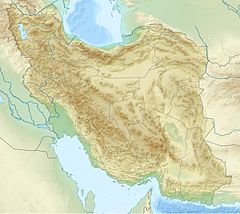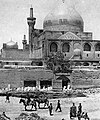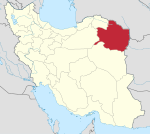Goharshad Mosque
This article needs additional citations for verification. (October 2017) |
| Goharshad Mosque | |
|---|---|
 The monumental "Maqsura" Iwan along with the dome and minarets of Goharshad Mosque. | |
| Religion | |
| Affiliation | Sunni Islam |
| Location | |
| Location | Mashhad, Razavi Khorasan Province, Iran |
| Administration | Astan Quds Razavi |
| Geographic coordinates | 36°17′14.55″N 059°36′52.89″E / 36.2873750°N 59.6146917°E |
| Architecture | |
| Architect(s) | Ghavameddin Shirazi |
| Type | Jameh Mosque |
| Style | Timurid |
| Founder | Empress Goharshad |
| Specifications | |
| Dome(s) | 1 |
| Dome height (outer) | 43 meters |
| Minaret(s) | 2 |
| Minaret height | 43 meters |
Goharshad Mosque (Persian: مسجد گوهرشاد) is a grand congregational mosque built during the Timurid era in Mashhad, Razavi Khorasan Province, Iran, which now serves as one of the prayer halls within the Imam Reza shrine complex.
History
[edit]It was built by the order of Empress Goharshad, the wife of Shah Rukh of the Timurid dynasty in 1418 CE.
The double-layered dome of the mosque was severely damaged in 1911 in bombings by troops of the Russian Empire. In the 1960s, the dome of Goharshad mosque was deemed to be in severe structural danger, damages caused by various earthquakes over time, the 1911 Russian bombings, and the attack on the mosque by Reza Shah during the 1935 rebellion required the dome to be rebuilt. By the order of Mohammad Reza Shah, the tiles from the ancient dome were removed in the 1960s and the external shell was dismantled. A new external shell was built. The dome was re-tiled. While such repairs were necessary, they permanently altered the historic identity of the mosque.
Design
[edit]Arthur Pope, a scholar of Persian architecture, described the mosque in 1965 in these terms:
The first, and the greatest surviving, Persian monument of the fifteenth century is the beautiful mosque of Gawhar Shad (1418) now abutting the shrine of the Imam Reza in Mashhad. Its portal continues the Samarkand style of arch within arch, enriched by a succession of bevels and reveals that give it depth and power. The thick, tower-like minarets, merging with the outer corners of the portal screen, extend to the ground and, together with the high foundation revetment of marble, give the ensemble the impression of solidity necessary to support its exuberant color. The entire court facade is faced with enamel brick and mosaic faience of the finest quality....
— Arthur Pope, Persian Architecture: The Triumph of Form and Color[1][excessive quote]
Gallery
[edit]See also
[edit]References
[edit]- ^ Upham Pope, Arthur (1965). Persian Architecture: The Triumph of Form and Color. New York. p. 198. ISBN 978-0-8076-0308-6.
{{cite book}}: CS1 maint: location missing publisher (link)
External links
[edit]![]() Media related to Goharshad Mosque at Wikimedia Commons
Media related to Goharshad Mosque at Wikimedia Commons





